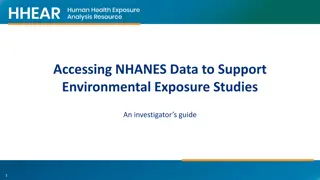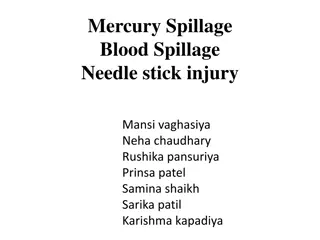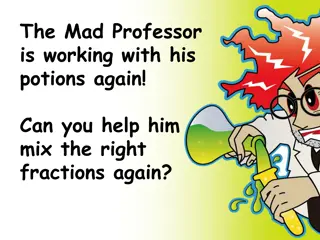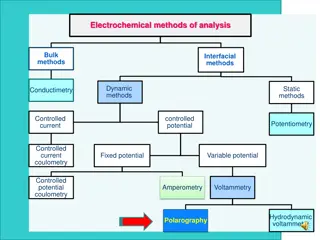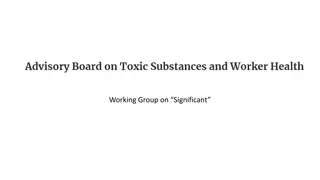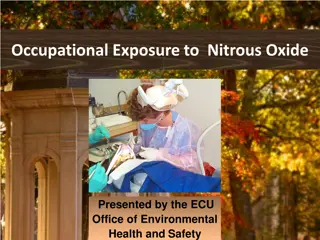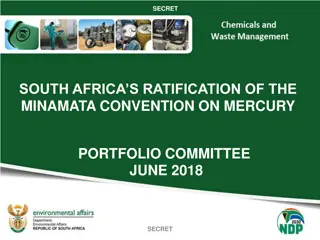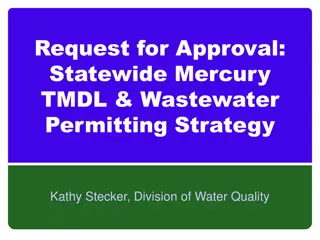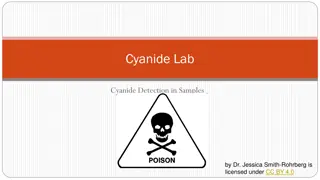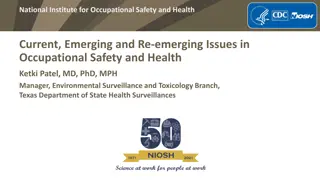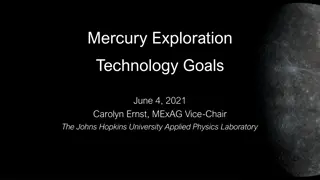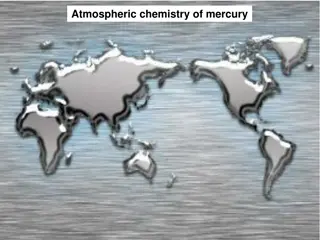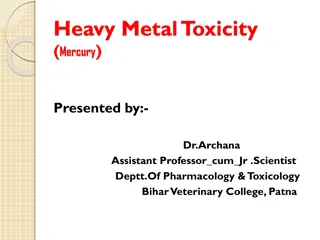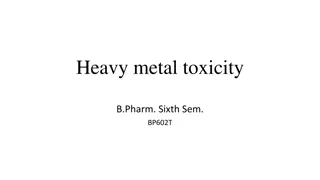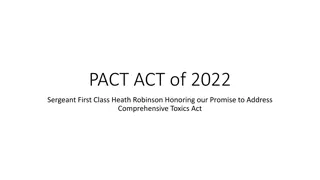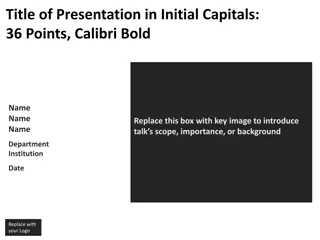Mad Hatters: Strategies for Reducing Mercury Exposure
This content delves into the topic of mercury exposure reduction through the lens of an institutional campaign. It explores the potential applications of strategies developed in the campaign to form a national public health initiative. The narrative revolves around the Mad Hatters Mercury Reduction campaign, its accolades, and the adverse effects of mercury exposure. Drawing inspiration from Alice in Wonderland, the content highlights the importance of addressing mercury pollution in a captivating and informative manner.
Download Presentation

Please find below an Image/Link to download the presentation.
The content on the website is provided AS IS for your information and personal use only. It may not be sold, licensed, or shared on other websites without obtaining consent from the author.If you encounter any issues during the download, it is possible that the publisher has removed the file from their server.
You are allowed to download the files provided on this website for personal or commercial use, subject to the condition that they are used lawfully. All files are the property of their respective owners.
The content on the website is provided AS IS for your information and personal use only. It may not be sold, licensed, or shared on other websites without obtaining consent from the author.
E N D
Presentation Transcript
Mad Hatters: Saving the World Or: Potential applications of strategies from an institutional mercury reduction campaign to develop a national public health initiative for reducing human exposure. Adapted from: Howard Faucett Award Acceptance Speech American Chemical Society 2005 Edward H. Rau Captain, USPHS, Ret. Division of Environmental Protection Office of Research Facilities National Institutes of Health Bethesda, MD 20892-5746 U.S. Department of Health and Human Services
A Tip of the Hat Unfortunately Ed could not be here to accept his award so asked me to come back from the past to give his acceptance speech. But he did want you to know that he was deeply, deeply honored to have received this award. His Mad as a Hatter Mercury Reduction campaign, (named after me) has received several recognitions including a citation from the Governor of Maryland. The Campaign has been going for just about 12 years. So now it s time for the Grand Plan 2
Speakers Disability Disclaimer We have a lot of hat factories around my home town of Danbury, Connecticut. Demand for our hats is so big that we had to start making them out of cheap stuff like wool instead of beaver fur. These hats have to be stiff and shiny so we have special recipes (secretage) for the wool forming process called carroting. We used to use camel urine * (really!), then tried a locally sourced product provided by our hatters and now use mercurous nitrate. It s works good but makes but us forgetful, sleepless, a little confused in our speech, distracted and unsteady. Some call it the Danbury Shakes. Others say we re just MAD. *Even in your day this ingredient is still scarce around Connecticut. But severe mercury pollution from our hat factories is still present in 2012. 3
Opening Words A reading attributed in 1865 by Luis Carroll to one of my co-workers, an acquaintance of Alice: "Twinkle, twinkle, little bat! How I wonder what you're at! "Up above the world you fly, Like a tea-tray in the sky. Twinkle, twinkle--" 4
Was this just --An attempt by my colleague to recite a forgotten nursery rhyme? ---Or lines written for a fictional character to fit a story line? No, you missed it. Listen closely. It was one of two warnings about mercury heard in Alice s story. 5
The Second Warning from Wonderland You better listen this time - it s about all of you "In that direction," the Cheshire Cat said, waving its right paw round, "lives a Hatter: and in that direction," waving the other paw, "lives a March Hare. Visit either you like: they're both mad." "But I don't want to go among mad people," Alice remarked. "Oh, you can't help that," said the Cat: "we're all mad here. I'm mad. You're mad." 6
Today, the Cat May be Right Actually, all of you may be going mad Releases of mercury to the environment are 5 to 6 times higher than they were before the industrial era. It s bioaccumulating in wildlife - not just the fish even the song birds of Vermont according to a recent study. CDC data 10% of women of childbearing age have body burdens that may be unsafe for the developing fetus, resulting in learning deficiencies and delayed mental development. Perhaps connections with increased incidence of autism and increasing resistance of infectious agents to antibiotics. New information suggests impacts on adults as well subtle neurological changes, insomnia and associations with cardiovascular disease. ---All of this is what my campaign platform is all about: 7
Campaign Beginnings It s roots go far back - in the late 1930 s with research on mercury at the National Institutes of Health (NIH), in Bethesda, Maryland . That ultimately led to the ban on its use in hat making just a few days before the beginning of World War II. My campaign began on Earth Day 2001 at NIH as a voluntary initiative with primary goals of encouraging employees to use mercury-free devices and reagents to reduce potential for spills, occupational exposures and pollution. Soon all of NIH joined. And then some other agencies. Community outreach was originally intended as a minor element of the campaign, part of our campaign kick-off event. But my theme and messages proved more popular with the public than even a Mad Hatter could hallucinate 8
Additional Campaign Accomplishments Since then: Tens of thousands more participants: website visitors, attendees at health fairs, presentations, thermometer exchanges, Mercury- Free Hatter s Pledges made. Mercury spills have been a huge problem in schools through out the land so I hosted a national video web cast workshop on mercury reduction and pollution prevention in schools in partnership with EPA, Maryland environmental and educational agencies, and universities. We shared campaign tools with UN Environment Programme (UNEP) mercury initiative. Campaign summary presentation is on the UNEP website. (My picture is there too). We completed several major laboratory facility decommissioning projects involving mercury decontamination - working with MIT, Harvard, HHMI to develop protocols that ultimately became the national consensus standard. 9
Some Lessons Learned From My Campaign So Far
Lesson #1 (Most Important) Hatters Are Good Teachers OUR FIRST STUDENTS (YOU) WERE JUST SLOW LEARNERS: 1860 - the first of several major studies confirmed mercury was poisoning us. 1865 - Alice (of Wonderland) had me to a tea party and noticed something was wrong but didn t know what it was. (She didn t get my riddle either). 1925 - Another Alice (Hamilton) did get it and devoted an entire chapter to the hat industry in her classic work, Industrial Poisons in the United States. 1941 - Use of mercury in hat making was finally banned by Ed s predecessors in the U.S. Public Health Service. 11
Lesson #2: Think Out of the Hatbox You shouldn t spend all of your prevention efforts on occupational exposures in institutional environments such as labs (and hat factories). A more holistic approach as practiced in my campaign is needed to protect your employees from health and safety hazards of chemicals like mercury because: Unlike most lab chemicals, there are sources of significant acute exposure outside occupational setting homes, schools etc. Everyone has some level of chronic exposure from dietary intake - for a significant population fraction it is already an over exposure. Mercury uptake is cumulative and toxic effects occur at very low levels. 12
Lesson #3: Don t Rely on Occupational Standards They May Not Be Protective Better to Use Risk-Based Exposure Standards Established for the General Population: OSHA regulations, exposure guidance by NIOSH and others are based on very old data, assume that workers are healthy , exposed only at work, and that they work only a 40 hours a week. Workers in academia, health care and research often work longer hours than that they live in their labs. Workers are not healthy - we know that about 1 of every 6 female workers of child bearing age reports to work already overexposed to mercury. Our built environment also houses patients, visitors and research animals who may be much more sensitive to mercury than workers. 13
Lesson #4: Proactive Approaches by Institutions are Required to Cope With New Limits `I can't go no lower,' said the Hatter: `I'm on the floor, as it is.' Allowed exposure and emissions limits for mercury are going lower and will continue to drop in response to evidence of health and environmental impairment at levels of exposure far below some current limits. Most extreme example: the discharge limit for mercury in wastewater from treatment plants in EPA Region 5 has been lowered to 1.5 parts per trillion. Treatment plants that cannot meet these limits will be required to impose controls on upstream sources, and labs, dental offices and other mercury users are being specifically targeted in guidance for developing required reduction plans. Developing institutional strategies to meet these new limits will require a proactive, long term approach and major commitments of resources. 14
Lesson #5: Mercury Contamination Isn t Just an Occupational Health Concern We are justifiably concerned about worker exposure to toxic chemicals but should not overlook potential impacts on the other occupants and activities that occur in indoor environments like learning, research and health care. WHAT ARE THESE IMPACTS? Mercury is often present as a contaminant in schools, labs, hospitals and dental clinics in the air, on surfaces of equipment, casework and floors, in plumbing, janitorial chemicals and even lab reagents in like methanol. Contaminated areas can promote the growth of bacteria with resistance to multiple antibiotics like MRSA (Methicillin Resistant Staphylococcus aureus) that present serious infection hazards to patients in health care facilities. At very low levels of exposure mercury can cause subtle neurological symptoms, reduced cognition and learning disabilities. 15
The Lesson is Confirmed by the Lab Mice The immunotoxic effects of mercury its capability to alter immune responses in animals can result from extremely low levels of exposure. Example - Subtoxic exposures to mercury have been shown to cause autoimmune disorders, enhanced susceptibility and impaired murine responses to parasitic diseases such as leishmaniasis and Plasmodium yoelii infections. In fact, There is evidence that the resurgence and severity of malaria (caused by another species of Plasmodium) noted in Amazon River Basin a is associated with increased mercury emissions from its use in artisanal mining activities in the region. Mercury may interfere with biological processes at extremely low levels and could alter the outcome of biomedical experiments performed in mercury contaminated laboratory environments. 16
And Dormice? But what did the Dormouse say?' one of the jury asked the Hatter. He couldn t remember or didn t know. --Like that Hatter, we may not know what the lab mice are saying. 17
Whats Next: My New Campaign Platform Expand successful our community outreach approaches as a national or international campaign to reduce human exposure. The campaign would be focused on two primary sources of exposure: spills and excessive dietary uptake. 18
Prevent Acute Exposures to Vapors by Prevent Acute Exposures to Vapors by Eliminating Sources of Spills Eliminating Sources of Spills Improve public awareness of mercury containing items and the hazards they pose. Encourage replacement of mercury devices at work, schools and in homes. Facilitate proper recycling and disposal At household hazardous waste collection sites. Community thermometer exchanges. Provide guidance on proper spill clean up methods and links to resources for spill detection, decontamination and disposal. 19
Reduce Chronic Exposure by Reduce Chronic Exposure by Increasing Awareness of Increasing Awareness of Healthy Healthy Diet Diet Regardless of pollution prevention approaches, reductions in mercury emissions and concentrations in the food chain will take years to achieve. But exposure can be reduced now by encouraging people to change consumption patterns of fish, the primary source of mercury exposure for most of the population. This will require delivery of a complex health education message to: Promote health benefits of eating more fish Yet reduce the risk of excessive mercury exposure by carefully selecting caught and purchased fish with lower mercury content. Campaign methods Provide outreach materials with the latest dietary guidance. Distribute information on state and local fish advisories. 20
Campaign Expansion: How would it work? Use the same methods as the institutional campaign: Copy and translate materials and methods from this and other similar campaigns. Methods are adaptable and easily scalable. Use volunteers, public service ads and the Internet to deliver the message. No national public health problem of this magnitude has ever been addressed for such a minimal investment: Little additional funding required. No new drugs need be developed. No new regulations to be promulgated. 21
Continue Focus On Protecting Children (Hatter s Helpers) WHY? The unborn and very young children are at highest risk of toxic effects from very low levels of exposure to mercury. With its interesting properties, bright shiny appearance children are enticed to play with it. Getting the mercury safety message to teachers, parents and children is critical. Most reported spills in the U.S. are in schools Spills can result in extremely high costs clean up costs and downtime associated with school closures. Schools have limited funds and clean-up expertise. They are easily preventable by eliminating sources. 22
To be Successful I Need Your Help Take the Hatter s Pledge for the New Campaign: Get involved. Build and reinvigorate partnerships - with public agencies, non- governmental organizations, private sector. Work with school programs - Train the teachers, teach students about mercury hazards and how to avoid them. Share limited resources more efficiently your expertise, case studies, mercury detection equipment, websites and publicity tools Maybe even costumes. 23
Closing Words We must succeed in these efforts so our children can recite the rhyme as it should be: Twinkle, twinkle, little star, How I wonder what you are. Up above the world so high, Like a diamond in the sky. Twinkle, twinkle, little star, How I wonder what you are. With senses and intellect unimpaired, Let them experience all the Wonder. And discover what they are 24
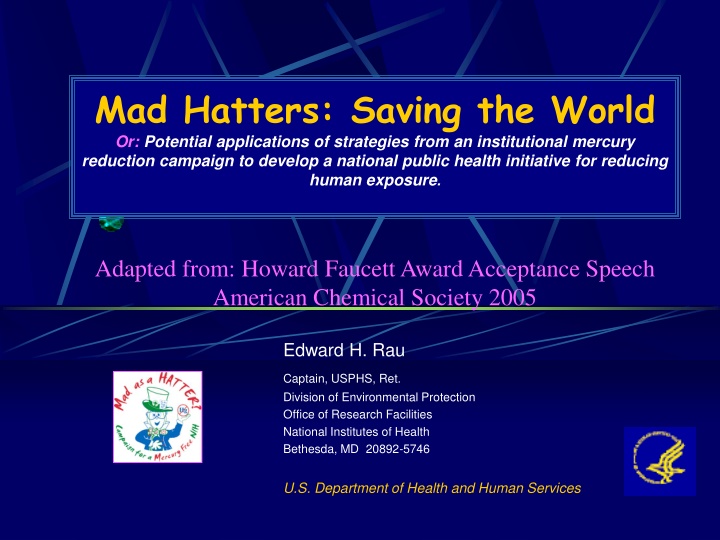

![[PDF⚡READ❤ONLINE] Planet Mercury: From Pale Pink Dot to Dynamic World (Springer](/thumb/21549/pdf-read-online-planet-mercury-from-pale-pink-dot-to-dynamic-world-springer.jpg)


